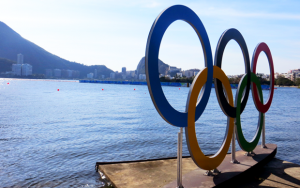A Show Of Contradictions
August 16, 2016

ARHU Rio expert shares perspective on the 2016 Olympics.
By Liam Farrell | Terp Magazine
Even to a Rio de Janeiro expert like Daryle Williams, this year’s Olympiad has been an eye-opening way to look at what he calls a “wonderful, complex and confounding city.”
Williams, an associate history professor at the University of Maryland and lead editor of The Rio de Janeiro Reader, traveled to Rio for the first part of the 2016 Games and will return for the Paralympics in September. He’s found some portions of the city are filled with Olympic fever, while others are just going about the everyday.
“There’s all this juxtaposition,” he says. “You go from one neighborhood to another and it feels like a very different place.”
Those contradictions are omnipresent in the metropolitan area of 12 million, where seductive beaches and party culture coexist with choking pollution and shocking violence. Heading into the Olympics, observers around the world were skeptical that Rio could handle an influx of 500,000 tourists amid challenges including the Zika virus outbreak and presidential impeachment drama.
Williams, who has lived in the city, listed several undeniable hiccups this month, including brazen street crime and poor signage. The pools at the Maria Lenk aquatics center turning from a crisp blue to a blurry green—attributed to a chemical mishap—was particularly embarrassing.
“It’s green!” says Williams, who saw Brazil defeat Serbia in men’s water polo in those murky waters. “And you’re like, how could this have happened?”
The most recent bad news came out over the weekend, with word that several members of the U.S. swim team, including medalist Ryan Lochte, had been robbed at gunpoint.
“With and without the Olympics,” notes Williams, “Rio is a city plagued by gun violence.”
Like in London for the 2012 Summer Olympics, he senses a growing civic pride in pulling off the event. But Williams has a more cautious view on the legacy of Rio 2016, particularly as the wider world comes face-to-face with the “intractable problems of the city’s environmental pollution.” The filthy water of Guanabara Bay—a place that the Brazilians have promised to clean up for decades and recently sickened a Belgian sailor—is emblematic.
“The failure to meet clean-up goals is going to make a really lasting impression on the Games’ missed opportunities,” he says.
For the people of Rio, he predicts a mix of positives and negatives. On the one hand, the Olympic Village will be turned into luxury condominiums—essentially a government subsidy for the affluent; on the other, new rapid bus lines could reduce traffic jams for the working class.
Williams hopes the world doesn’t turn away when the crowds leave its pools, volleyball sands and gym mats. For him, the allure of Rio makes it a place worth always engaging.
“Some of that (draw) is complete fantasy,” he says. “But there’s also something about that attraction that should continue to engage the global audience.”
For more Rio observations from Williams, check out his essays on the Duke University Press blog.
Photo via TERP Magazine courtesy of the UMD History Department, Jorge Andrade and Rafa Bahiense

